If you’re anything like me, then you’ve found yourself enjoying a game of Solitaire on more than one occasion. It’s a classic pastime, one that offers both relaxation and mental stimulation. But, let’s face it, playing the same easy game over and over can become monotonous. Although 80% of Solitaire games are winnable, it’s good to take on a challenge from time to time.
This is where the real fun begins. Among the 500 variations of this timeless game, there are a few that truly put one’s skills to the test. Whether it’s navigating through the intricate webs of Spider Solitaire or tackling Yukon, the variants I will discuss here should ensure that you always keep coming back for more. So, clear your mind and pay close attention. Here are the 10 most difficult Solitaire games. They are sure to spice up your card-playing experience!
Spider Solitaire
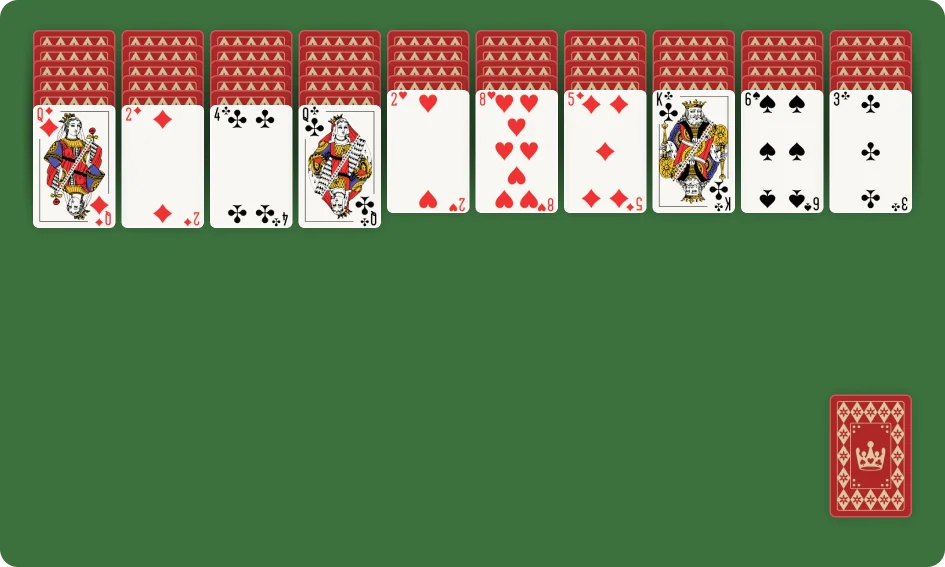
Spider Solitaire stands as a titan among Solitaire variants and is known for its difficulty and unforgiving gameplay. Featuring a deck of 104 cards, the game’s objective seems deceptively simple: Constructing eight foundation piles, each beginning with an Ace and ending with a King. However, this game requires careful planning. To be honest, when I first saw its layout, I hit Alt+F4!
If you’re intimidated by Spider Solitaire (like I was), then don’t worry. Some of this game’s unique rules can actually make life easier. Specifically, if you have no valid move left to play, then you can draw 10 cards from the stock and place each on top of a pile. This opens up many more options. Spider can also be easier if you opt for the one-suit variation (only Spades) or two-suit variation (only Spades and Hearts). The fewer the suits, the easier the game.
Tips to Win
- Try to move cards from columns that have the fewest cards. By using empty piles to store cards, you can make the complicated layout simpler.
- Begin with high-ranking cards. If you begin with a low-ranking card, then an Ace will quickly end the pile, and you can’t stack any cards on top of an Ace. You can add additional cards if you begin with higher cards.
- In Spider Solitaire, Kings are tough to deal with. It’s difficult to access cards beneath them because they form the base of the sequences. The best strategy is to either move them to an empty spot or finish their sequences first.
Yukon Solitaire
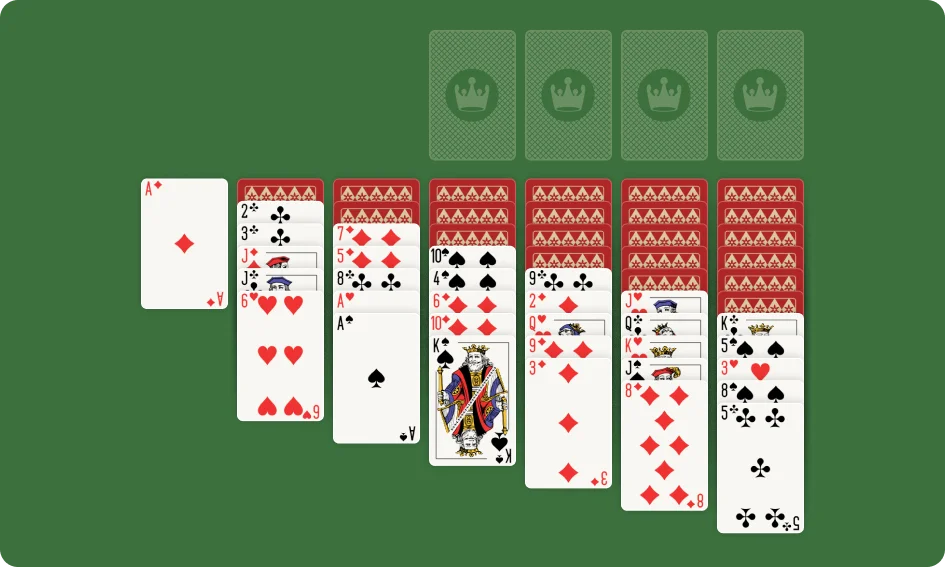
With a winning percentage of 12%, Yukon Solitaire offers a twist on the classic game. I went in thinking that it would be easy given that one only needs to make four foundation piles. However, there is no Stock, which makes it difficult for even experienced players. This variant not only requires strategic thinking but also foresight.
I recall my first time playing. I struggled a lot due to the absence of a stock. But then, I found out about the ‘super move’ rule, which (thankfully) allows you to move cards as long as the first card in the pile is a rank lower or the opposite color from the card you are placing it on (regardless of the remaining cards in the sequence). This makes progressing in the game quite a bit easier.
For me, Yukon isn’t just a game. It’s an immersive experience, one that tests my mental abilities to their fullest.
Tips to Win
- The foundations start with Aces. As such, you should prioritize clearing as many of them as you can. Make room for Aces by moving cards underneath.
- Start by emptying the leftmost column, which only has one card at the beginning.
- Try to reveal all cards at the start of the game. The more cards you expose, the easier it will get for you to build the foundation piles.
FreeCell Solitaire
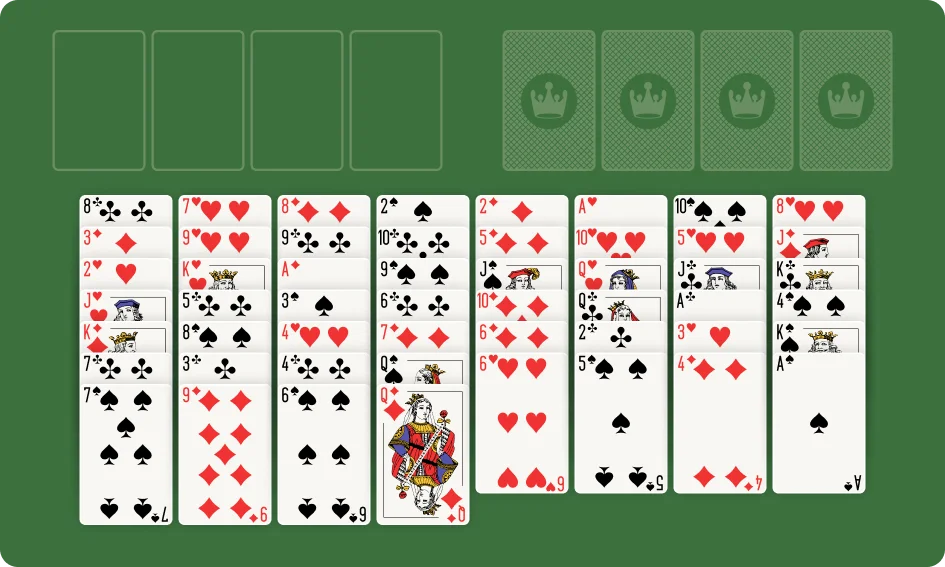
You might be surprised to see FreeCell Solitaire here because it’s mostly played by beginners. However, the limited number of moves and the variety of choices make it a challenge for most of us. The main objective is to make four suit-specific piles from Aces to Kings. However, the most important feature of this variant is the ‘free cells’, which store cards one at a time.
The free cells help you by holding cards, and this flexibility makes the game easier. When I started playing FreeCell, I was confused by the game’s layout and the interplay between the tableau and free cells. But, once I got the hang of things, the game became genuinely enjoyable. So, give it a shot (but use patience).
Tips to Win
- Don’t move cards into the free cells until absolutely necessary. Not doing so can cause confusion while moving cards.
- Concentrate on moves you can make to reveal Aces, Deuces, and Threes, especially if they are in difficult-to-reach spots. This will help you build the foundation piles. Otherwise, you risk running out of playable moves early in the game.
- Moving cards from columns with lots of cards should be your top priority if you have numerous possibilities on the tableau. By doing this, you can make room for the cards you need to play with if you are going to proceed. This works especially well if you can fully empty a column to make more room.
Pyramid Solitaire
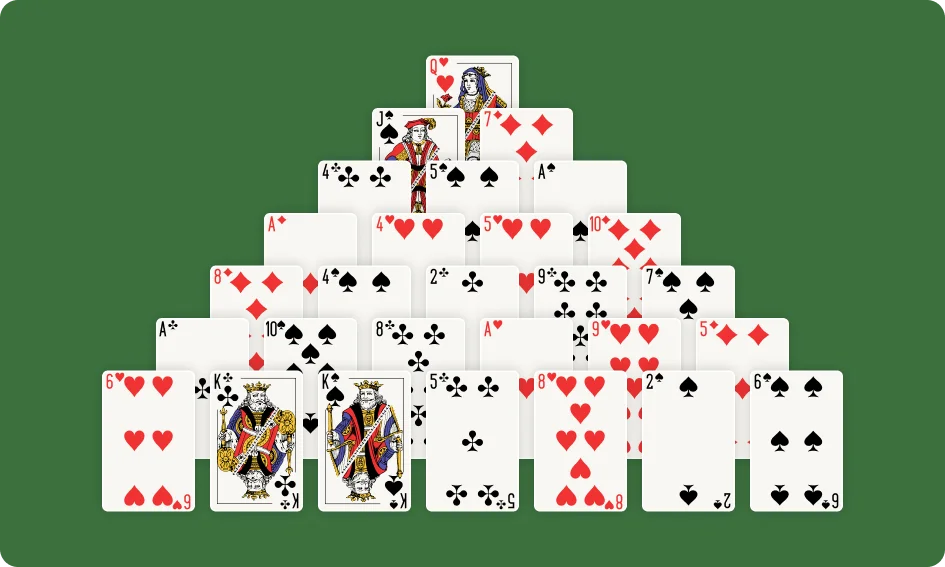
Also known as ‘King Tut’ or ‘Tut’s Tomb’, Pyramid Solitaire is considered one of the most challenging Solitaire variants. The primary goal is to remove cards that add up to 13 until the entire pyramid is cleared. This might sound easy, but the game requires keen strategic thinking to match the relevant cards and clear the pyramid.
This Solitaire variant’s unique layout makes it both noticeable and interesting. The tableau’s pyramid-shaped arrangement intimidated me when I first played it. Moreover, the pyramid layout becomes increasingly complex as the game progresses, with fewer opportunities for matches. It is, nonetheless, possible to get a hold of things after a few practice sessions.
Tips to Win
- Try to remove the cards evenly from the pyramid on both sides. This will ensure that you don’t unnecessarily complicate the layout.
- A King is equal to 13 and doesn’t require another match. So, always remove Kings when you get the chance. Consider it a free card of sorts.
- Play from the discard pile instead of the deck. This allows you to play a useful card while revealing another card, which can, in turn, help you with another pair-forming opportunity.
TriPeaks Solitaire
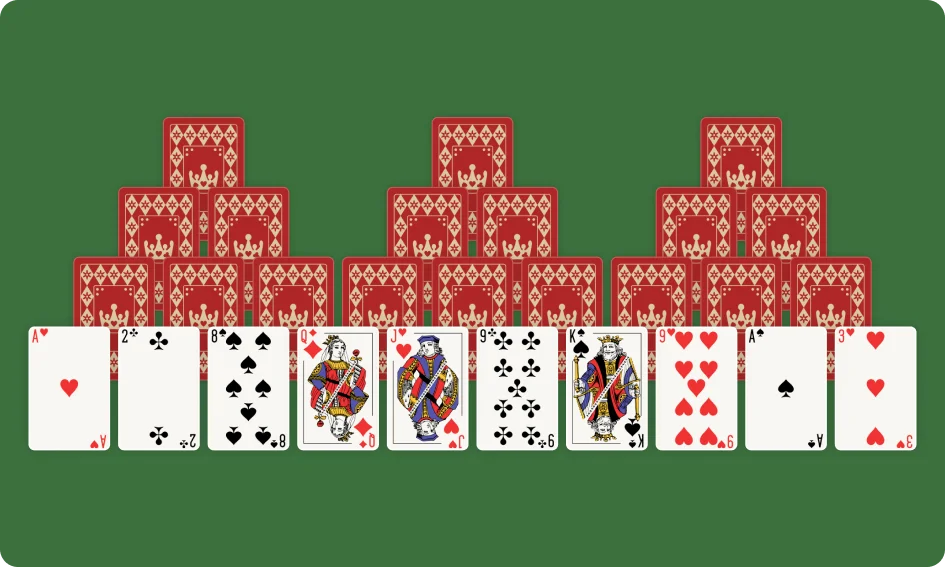
TriPeaks Solitaire offers a new twist on the traditional game by challenging players to conquer peaks. The entire layout takes the form of three pyramids, which you must clear. Once you clear these peaks, you win the game.
However, this is not easy. Clearing the three peaks requires planning and foresight. One move can either open up new possibilities or block your progress. Nonetheless, this variant’s difficult gameplay is sure to sharpen your skills.
Tips to Win
- Building longer sequences helps you score more. This, in turn, helps you win the game.
- Uncover cards systematically. Move from one row to another. This helps you reveal more cards in each peak.
- Uncover face-down cards as soon as you can. This opens up more opportunities for moves.
Golf Solitaire
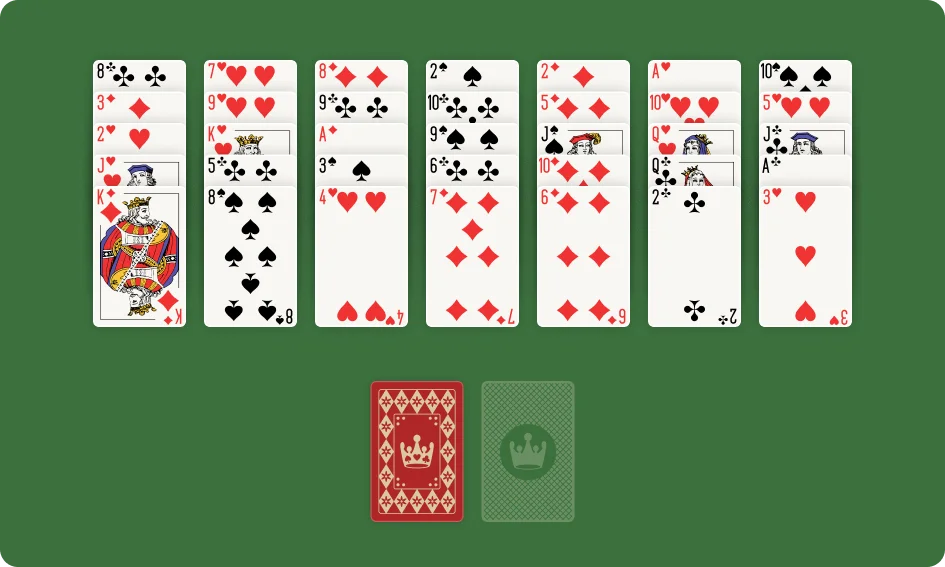
Golf Solitaire is another tricky variant, one that mixes the sport of golf with Solitaire. The primary goal is to transfer all cards from the seven columns in the tableau to the reserve pile. The game offers a unique challenge because the gameplay is quite different from traditional Solitaire. Cards that can be transferred to the pile must be either one rank higher or lower than the topmost card in the pile. Aces and Kings are considered consecutive, which means that you can place an Ace on top of a King and vice versa.
The layout seems simple, but remember that looks can be deceiving. I thought that I only had to clear the tableau by making sequences. But, I found out that there are limitations related to reshuffling.
Tips to Win
- In this game, empty piles are essentially useless. You should, therefore, browse through the longer piles to find additional cards.
- Count and memorize rejected cards. Don’t rush to remove cards in extended sequences. For example, if you discard all of the Three and Fives, the Fours might get trapped.
- Maintain a consistent playing routine. The easiest way to become acquainted with the game flow is to play often.
Clock Solitaire
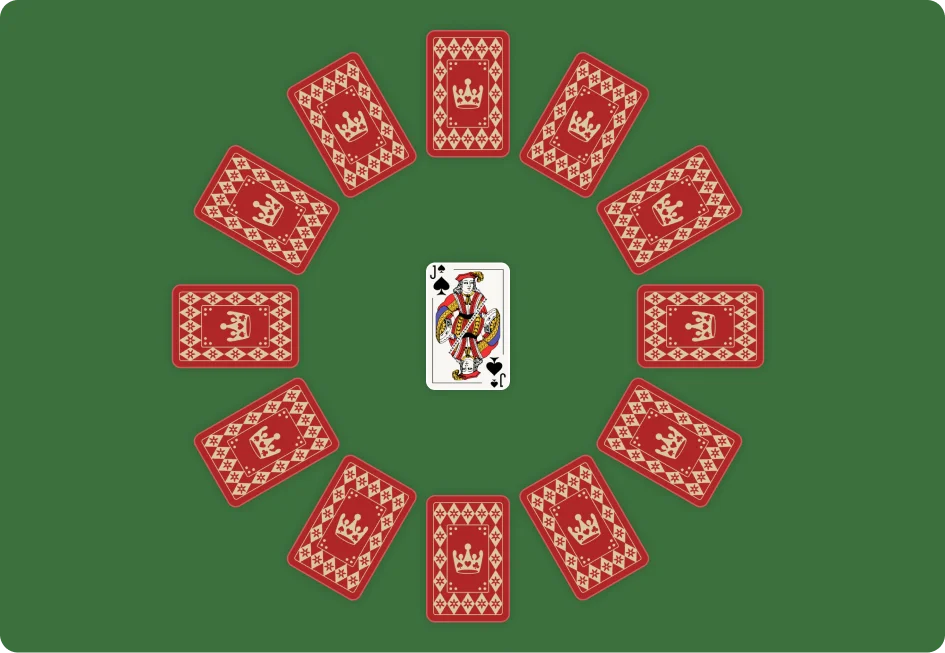
True to its name, Clock Solitaire has a layout in the shape of a clock face. The game starts with 13 cards in a circle, representing a clock. The main aim is to place cards in their clockwise positions. Aces go into the 1 o’clock pile, Deuces go into the 2 o’clock pile, and so on. One card in the center is for the draw pile.
This game took me several tries to master. Arranging cards while keeping the clock patterns in mind can be difficult. That said, the game’s difficulty lies in its win rate rather than its gameplay. With a 7.6% chance of winning, this variant can scare off players, especially beginners. One needs lots of patience to succeed in this game.
Tips to Win
- Unlike other Solitaire games, which can be won with strategic planning, Clock relies on luck.
- This variant can, however, require patience and a good memory. After all, you must remember the clock layout while arranging the cards.
Baker’s Dozen Solitaire
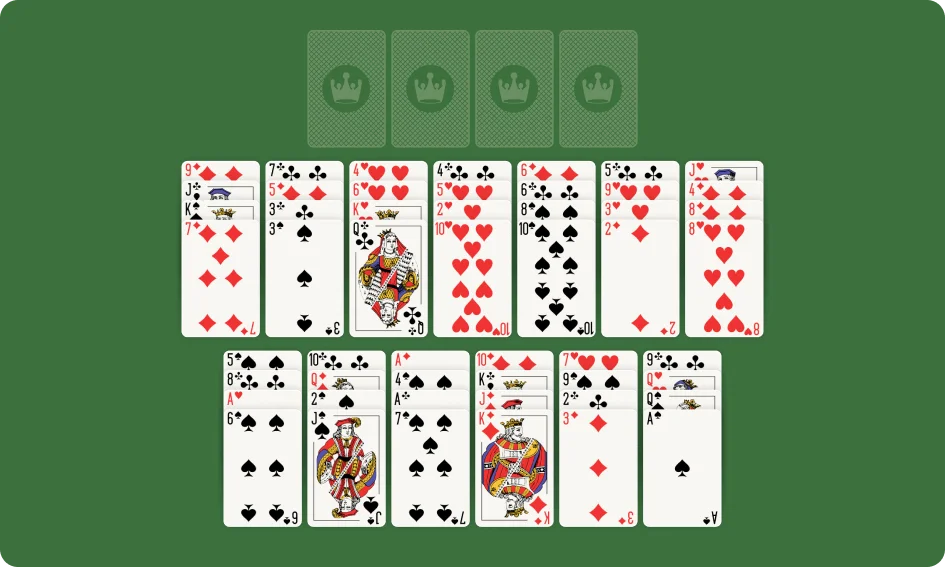
Baker’s Dozen Solitaire is a game that keeps players on their toes, irrespective of experience. Unlike most Solitaire games, where cards can be moved freely in the tableau, this variant restricts your moves. The restricted moves can make the game difficult but also entertaining. Other than that, the objective is pretty simple – fill four foundation piles.
At first, I was taken aback by this variant’s seemingly simple layout when compared to others on this list. Yet, as I began playing, I realized that its simplicity was just a mask. I’ve experienced many moments of frustration when I couldn’t find the right cards to uncover the hidden ones. This kind of challenge can, nonetheless, provide the best mental stimulation.
Tips to Win
- To maximize space, empty columns first and start with face cards like Kings and Queens.
- Place low cards – such as Aces and Deuces – in the foundations wherever feasible.
- Use vacant areas for storing cards, but, only if necessary. Otherwise, things can get confusing.
Canfield Solitaire
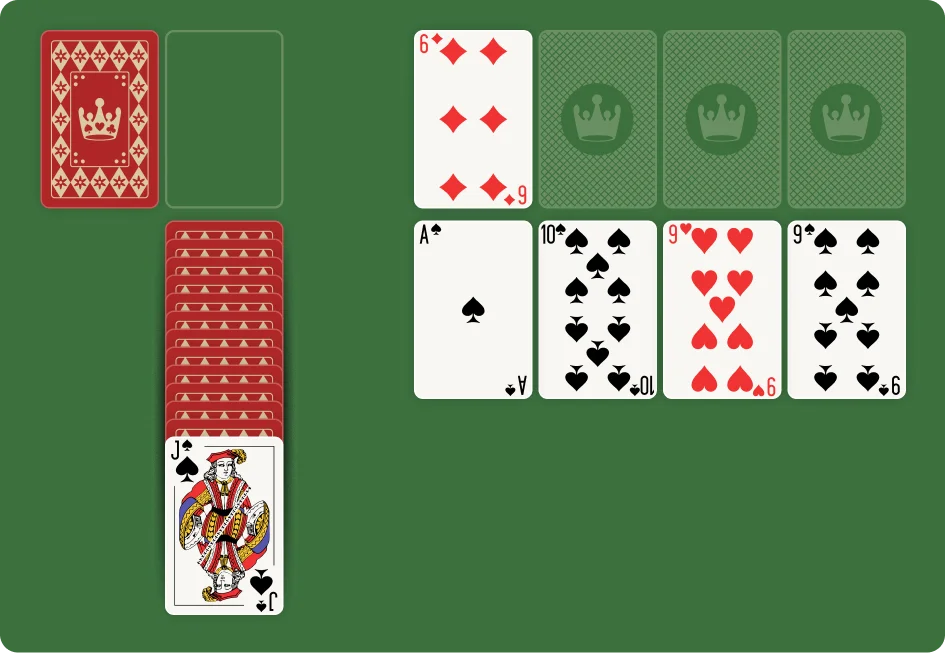
Named after casino owner Richard Canfield, Canfield Solitaire only has a 3% win rate. The primary goal sounds easy – build four foundation piles. But, the game is known as ‘Demon Patience’ in the UK for a reason. After playing it, I understand why. In traditional Solitaire, one has some flexibility in moving cards around the tableau. However, Canfield restricts access to empty columns, which makes the game particularly difficult.
With limited empty columns and restricted access to the stock, this Solitaire variant offers a challenge to even experienced players. I found out the hard way that this game requires patience. Every move requires careful consideration. If you make one wrong move, you will end up scratching your head, trying to make sense of the chaotic layout.
Tips to Win
- To succeed in this game, make sure that you deal with most of the cards from the stock.
- Try to construct as many openings as possible at the start of the game.
- Also, remember to create the foundation piles evenly. For example, playing a black Five before you can locate the red Sevens is a mistake because it can make finding these cards difficult later on.
Aces Up Solitaire
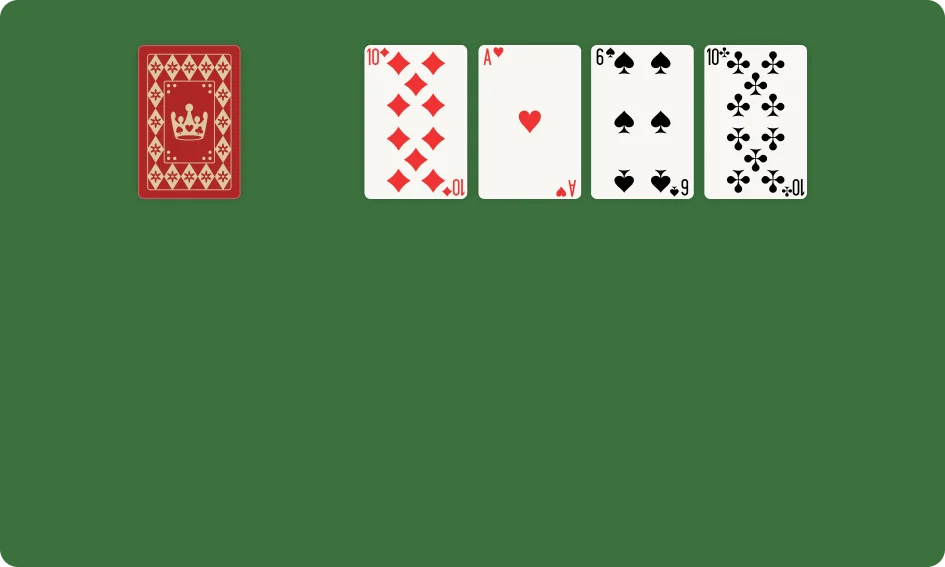
The objective in Aces Up Solitaire is to discard all cards from the four tableau piles to the foundation. You must, though, leave the four Aces in the tableau piles because they have the highest rank. This variant’s rules are tricky to grasp. But, once I understood them, I found the game to be quite simple – just a little tough to learn.
In this variant, Aces count higher than Kings, and you should not remove them. The sequence goes A, K, Q, J, 10, 9, 8, 7, 6, 5, 4, 3, 2. This unique hierarchy adds extra complexity to the game. Indeed, it frustrated me endlessly when I was new to it.
Tips to Win
- Prioritize removing cards that are blocking the Aces in the tableau. This ensures that your Aces are accessible at the start and gives you more opportunities for moves.
- Try to fill empty spaces with any available card. This way, you can easily navigate through the layout and find opportunities for new moves.
- Remove cards of lower values. For instance, if the tableau has a Four of Hearts and a Seven of Hearts, then you should discard the Four of Hearts.
What Makes a Solitaire Game Difficult?
Now that you’ve been introduced to the most challenging Solitaire games, you might be wondering about what determines a game’s difficulty in the first place. Here are four factors to take into account before deciding whether or not to play any given Solitaire game.
Scoring System
Solitaire games that have a scoring system are considered more difficult. This is because they have two goals: a main one (which is mostly about building foundation piles) and a secondary one (which is to score more points). A game might demand that players maximize points while attempting to win. This adds a new level of difficulty to the whole process.
Variability
Some games are quite simple and predictable. Others have random components that present new difficulties each time the game is played. Players might, for instance, have to place cards in complicated set-up positions. This can lead to radically different gameplay scenarios, making the pertinent variant more challenging than regular Solitaire.
Rules
Some Solitaire games have more rules than others, which makes them more complicated. Such rules might vary from limiting the number of moves to reshuffling restrictions. In some cases (like TriPeaks Solitaire), there is also a time limit, which naturally makes the game even more challenging (not to mention stressful).
Luck
A game that is mainly reliant on luck and allows little option for strategic decisions might be deemed more challenging because the outcome is largely unpredictable. Even experienced players can lose a game that is mostly luck-based (like Clock Solitaire).
| Factor | Description |
| Scoring system. | Achieving a high score makes it difficult for players to focus on the main game. |
| Variability. | Some features mean that the gameplay varies significantly from game to game. This can be challenging. |
| Rules. | The more rules, the more limited a player’s moves are. |
| Luck. | Some games depend more on luck than strategic thinking. |
Conclusion
Playing conventional Solitaire might be your passion, but it’s good to shake things up a bit once in a while. I tend to enjoy games when they push my skills to the limit. Winning can then introduce a whole new level of excitement. So, if you feel like challenging yourself (while exercising your mental muscles), then try out these difficult Solitaire variants.





